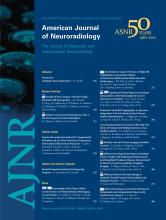Abstract
BACKGROUND AND PURPOSE: Until now, endovascular treatment of symptomatic atherosclerotic stenosis in small intracranial arteries (≤2.5 mm) was limited. We evaluated the safety and efficacy of the treatment by using Wingspan stents in arteries of this caliber.
MATERIALS AND METHODS: From March 2007 to July 2010, 53 symptomatic intracranial stenoses with narrowing of at least 50% in 53 patients were treated by using Wingspan stents. Clinical manifestations and imaging features were recorded.
RESULTS: The technical success rate was 98.1%. There were no serious complications, with the exception of 1 patient who experienced a small cerebral hemorrhage caused by perforation of microwire. Thirty-nine patients (74%) were available for follow-up imaging with DSA. ISR was documented in 13 of these patients, including 2 patients with symptomatic ISR. The median length of the vascular lesions was 5.39 mm, and patients whose vascular lesions were longer than 5.39 mm had a much higher incidence of ISR than patients whose vascular lesions were shorter than 5.39 mm (53% versus 15%, respectively). The median ratio of the reference artery diameter to the stent diameter was 0.78, and patients whose ratio was smaller than 0.78 had a much higher incidence of ISR than patients whose ratio was larger than 0.78 (53% versus 15%, respectively).
CONCLUSIONS: In our series, percutaneous transluminal angioplasty and stent placement of small intracranial arteries by using Wingspan stents was safe. The ISR rate was relatively high; most patients having ISR were asymptomatic. Further follow-up is needed to assess the long-term efficacy of this procedure.
ABBREVIATIONS:
- ACT
- activated clotting time
- ISR
- in-stent restenosis
- LMA
- location, morphology, and access
- PTAS
- percutaneous transluminal angioplasty and stenting
- WASID
- Warfarin Aspirin Symptomatic Intracranial Disease
- © 2012 by American Journal of Neuroradiology
Indicates open access to non-subscribers at www.ajnr.org












